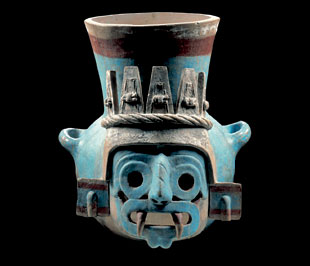|
























|
|









The Templo Mayor
The sophistication of the urban planning for Mexico-Tenochtitlan, capital city of the Aztecs, is unexpected. The metropolis was conceived as the Aztec axis mundi, as the very center of their sacred universe.
In accordance with the metaphoric image in the Codex Mendoza, the form of Mexico-Tenochtitlan is a quadrangular plane; the city was made up of the four original neighborhoods in which the entire tribe was accommodated after it was founded. The central space, also quadrangular, housed the most important ritual buildings. First among them was the Templo Mayor, the double pyramid dedicated to the worship of Huitzilopochtli, the patron of war, and Tlaloc, the god of rain.
The ritual architectural complex was expanded whenever an Aztec governor ascended to the throne, so that by the end of the 15th century, the fame of its monumentality and greatness had spread throughout Mesoamerica.
The Templo Mayor was decorated with elegant figures modeled in clay, such as the eagle warrior and Mictlantecuhtli, god of death, as well as stone figures that served as standard bearers.
The Aztecs' devotion to their deities led them to deposit hundreds of offerings that have been carefully recovered by archaeologists over the past 100 years. Outstanding among these are the images of various gods whose favor they sought through complex rituals.
Tlaloc pot. Aztec, ca. 1440–69. Fired clay, 35 x 35 x 31.5 cm. Museo del Templo Mayor, INAH, Mexico City. Photo Michel Zabé, assistant Enrique Macías.
|
|